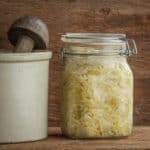How to Make Sauerkraut in a Crock
A basic homemade German sauerkraut recipe using a traditional fermentation crock. You can use green cabbage, red cabbage, or a blend.
Servings: 15 servings
Cost: 2
Equipment
- 1 Fermenting crock
- 1 Mandoline slicer, large chef knife or food processor
- 1 Fermentation weights or a clean stone
- 1 Cover for the fermentation crock use a plate in a pinch
- 1 Digital scale for weighing the salt
- 1 Mallet for pounding the cabbage
Ingredients
- 2 lbs Shredded green cabbage or other cabbage
- 18 grams Kosher salt (roughly 1 tablespoon)
Instructions
- Remove some of the outer leaves from the cabbage and save them for putting on top of the cabbage as it ferments.
- Shred the cabbage using a knife or mandoline slicer. Discard the cabbage cores.
- Weigh the cabbage in grams. Multiply the weight of the cabbage by .02, then add weigh out that amount of salt.
- Mix the cabbage with the salt and put the cabbage in the fermentation crock.
- Pound the cabbage using a mallet or other heavy tool until it's wilted and has started to release water.
- Put the reserved cabbage leaves on top of the pounded cabbage. Next put a fermentation weight or a clean stone on top and cover the crock with a lid. The cabbage should be barely covered by a layer of brine.
- Label and date the crock.
- Every few days you can check on the cabbage and stir it occasionally, pressing it back underneath the brine before putting the lid back on.
- After two weeks of fermenting at room temperature the sauerkraut will have achieved the maximum reduction in pH and is safe to can or store in the fridge.
- Put the sauerkraut in a mason jar, packing and pressing it down so that it's covered by brine. It will last a long time in the refrigerator.
